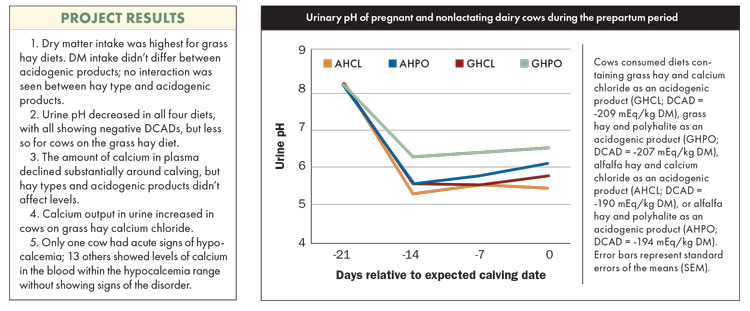Hay & Forage Grower is featuring results of research projects funded through the Alfalfa Checkoff, officially named the U.S. Alfalfa Farmer Research Initiative, administered by National Alfalfa & Forage Alliance (NAFA). The checkoff program facilitates farmer-funded research.

Alfalfa hay can be used in rations for pregnant and nonlactating dairy cows without necessarily causing metabolic diseases such as clinical hypocalcemia — also called milk fever. That’s the conclusion of recent research by Virginia Tech’s Gonzalo Ferreira.
The dairy management extension specialist used Alfalfa Checkoff funding to compare grass hay and alfalfa hay diets fed to prepartum cows with either calcium chloride or polyhalite mineral, which are acidogenic products that can prevent hypocalcemia.
“Typically, nutritionists avoid feeding alfalfa to prepartum dairy cows,” explained Ferreira. That’s because alfalfa, high in protein and energy, also contains high concentrations of potassium. Potassium can wreak havoc on a prepartum diet that is supposed to maintain a negative dietary cation-anion difference (DCAD), which improves calcium mobilization and reduces the risk of hypocalcemia in fresh cows.
But previous research Ferreira had completed on prepartum cows successfully consuming polyhalite salts as an acidogenic product got him thinking: “What if we can feed a large amount of these acidogenic products with alfalfa to be able to feed alfalfa without any (health) issues?”
He and Ahmerah Thompson, a Virginia Tech graduate student at the time, tested that theory by feeding 79 pregnant cows four diets using calcium chloride and polyhalite, each with grass and with alfalfa.
The grass hay contained 7.5% crude protein (CP), 74.9% neutral detergent fiber (NDF), 0.36% calcium, 0.09% sodium, 1.88% potassium, 0.38% chloride, and 0.15% sulfur. The alfalfa contained 19.6% CP, 45.6% NDF, 1.52% calcium, 0.16% sodium, 2.5% potassium, 0.77% chloride, and 0.32% sulfur. The grass hay had a DCAD equal to 289 mEg/kg dry matter (DM); the alfalfa hay’s DCAD was equal to 292 mEg/kg DM.
“We were expecting much more potassium in the alfalfa and less potassium in the grass hays. We were expecting to see a big difference in the amount of negative DCAD in alfalfa versus grass — with higher DCAD in alfalfa and lower in grass,” Ferreira said. But that didn’t happen.
Test the alfalfa
One important take-home message from this study was that not all alfalfa hays are the same in nutrient content, and the same is true for grasses. Nutritionists and farmers should have hay analyzed for the minerals it contains before it’s fed. They may be able to feed forages like alfalfa that they have avoided in the past, Ferreira pointed out.
The study looked at DM intake, urine pH, calcium concentration in the blood and urine, and the amount of hypocalcemia shown by cows consuming the diets. More DM was consumed by cows eating grass hay than alfalfa. Dry matter intake didn’t differ between acidogenic products, and no interaction existed between hay type and acidogenic products.

Urine pH declined in each of the four diets, all of which showed negative DCADs, but less so for cows on the grass hay diet. The concentration of calcium in plasma dropped substantially around calving, but hay types and acidogenic products didn’t have an effect. Calcium output in urine was elevated the most in cows on the grass hay calcium chloride diet.
Only one cow had acute signs of clinical hypocalcemia, which typically occurs when calcium concentration in the blood drops below 5.5 mg/dL, Ferreira said. “But several cows had low calcium concentrations at the clinical level (below 5.5 mg/dL) and did not show it as hypocalcemia. That is something intriguing to investigate further,” he added.
In his research report, Ferreira wrote that more study is needed evaluating fertility of the soil and the use of acidifying fertilizers “to better understand how to incorporate alfalfa hay in prepartum diets for pregnant and nonlactating dairy cows in the prepartum period.”

his article appeared in the April/May 2023 issue of Hay & Forage Grower on page 16-17.
Not a subscriber? Click to get the print magazine.

